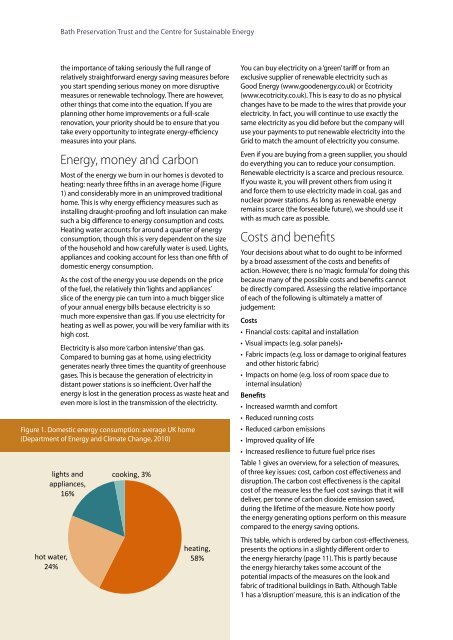Warmer Bath
Create successful ePaper yourself
Turn your PDF publications into a flip-book with our unique Google optimized e-Paper software.
<strong>Bath</strong> Preservation Trust and the Centre for Sustainable Energy<br />
the importance of taking seriously the full range of<br />
relatively straightforward energy saving measures before<br />
you start spending serious money on more disruptive<br />
measures or renewable technology. There are however,<br />
other things that come into the equation. If you are<br />
planning other home improvements or a full-scale<br />
renovation, your priority should be to ensure that you<br />
take every opportunity to integrate energy-efficiency<br />
measures into your plans.<br />
Energy, money and carbon<br />
Most of the energy we burn in our homes is devoted to<br />
heating: nearly three fifths in an average home (Figure<br />
1) and considerably more in an unimproved traditional<br />
home. This is why energy efficiency measures such as<br />
installing draught-proofing and loft insulation can make<br />
such a big difference to energy consumption and costs.<br />
Heating water accounts for around a quarter of energy<br />
consumption, though this is very dependent on the size<br />
of the household and how carefully water is used. Lights,<br />
appliances and cooking account for less than one fifth of<br />
domestic energy consumption.<br />
As the cost of the energy you use depends on the price<br />
of the fuel, the relatively thin ‘lights and appliances’<br />
slice of the energy pie can turn into a much bigger slice<br />
of your annual energy bills because electricity is so<br />
much more expensive than gas. If you use electricity for<br />
heating as well as power, you will be very familiar with its<br />
high cost.<br />
Electricity is also more ‘carbon intensive’ than gas.<br />
Compared to burning gas at home, using electricity<br />
generates nearly three times the quantity of greenhouse<br />
gases. This is because the generation of electricity in<br />
distant power stations is so inefficient. Over half the<br />
energy is lost in the generation process as waste heat and<br />
even more is lost in the transmission of the electricity.<br />
Figure 1. Domestic energy consumption: average UK home<br />
(Department of Energy and Climate Change, 2010)<br />
lights and<br />
appliances,<br />
16%<br />
cooking, 3%<br />
You can buy electricity on a ‘green’ tariff or from an<br />
exclusive supplier of renewable electricity such as<br />
Good Energy (www.goodenergy.co.uk) or Ecotricity<br />
(www.ecotricity.co.uk). This is easy to do as no physical<br />
changes have to be made to the wires that provide your<br />
electricity. In fact, you will continue to use exactly the<br />
same electricity as you did before but the company will<br />
use your payments to put renewable electricity into the<br />
Grid to match the amount of electricity you consume.<br />
Even if you are buying from a green supplier, you should<br />
do everything you can to reduce your consumption.<br />
Renewable electricity is a scarce and precious resource.<br />
If you waste it, you will prevent others from using it<br />
and force them to use electricity made in coal, gas and<br />
nuclear power stations. As long as renewable energy<br />
remains scarce (the forseeable future), we should use it<br />
with as much care as possible.<br />
Costs and benefits<br />
Your decisions about what to do ought to be informed<br />
by a broad assessment of the costs and benefits of<br />
action. However, there is no ‘magic formula’ for doing this<br />
because many of the possible costs and benefits cannot<br />
be directly compared. Assessing the relative importance<br />
of each of the following is ultimately a matter of<br />
judgement:<br />
Costs<br />
• Financial costs: capital and installation<br />
• Visual impacts (e.g. solar panels)•<br />
• Fabric impacts (e.g. loss or damage to original features<br />
and other historic fabric)<br />
• Impacts on home (e.g. loss of room space due to<br />
internal insulation)<br />
Benefits<br />
• Increased warmth and comfort<br />
• Reduced running costs<br />
• Reduced carbon emissions<br />
• Improved quality of life<br />
• Increased resilience to future fuel price rises<br />
Table 1 gives an overview, for a selection of measures,<br />
of three key issues: cost, carbon cost effectiveness and<br />
disruption. The carbon cost effectiveness is the capital<br />
cost of the measure less the fuel cost savings that it will<br />
deliver, per tonne of carbon dioxide emission saved,<br />
during the lifetime of the measure. Note how poorly<br />
the energy generating options perform on this measure<br />
compared to the energy saving options.<br />
h o t wate r,<br />
24%<br />
heating,<br />
58%<br />
This table, which is ordered by carbon cost-effectiveness,<br />
presents the options in a slightly different order to<br />
the energy hierarchy (page 11). This is partly because<br />
the energy hierarchy takes some account of the<br />
potential impacts of the measures on the look and<br />
fabric of traditional buildings in <strong>Bath</strong>. Although Table<br />
1 has a ‘disruption’ measure, this is an indication of the<br />
14


